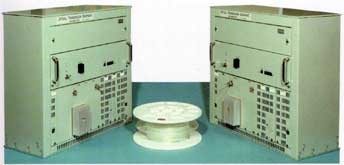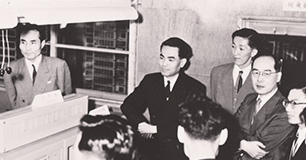32M Optical Transmission Equipment (1974)
Pioneering optical transmission technology and sparking the dawn of large-volume data communications

In 1970, Bell Labs, the research organization of America's telephone company AT&T, discovered semiconductor lasers capable of continuous oscillation. That same year, American glass manufacturer, Corning Inc., invented the first low-loss optical fiber. Optical fiber is quartz glass that has been fashioned into cable. Optical transmission systems with optical fiber transmission lines had suffered from the disadvantage that their signals were prone to attenuate, making them unsuitable for long-distance communication. Corning's low-loss optical fiber overcame this weakness.
Since 1969, Fujitsu's research arm, Fujitsu Laboratories, had been independently pursuing research, including the experimental prototyping, stabilization, and measurement of optical devices, to make this new system practical. This all out effort led to the creation of the 32Mbps Optical Fiber Transmission Equipment, which was delivered to NTT in 1974. Signal amplifiers called "repeaters" were inserted at regular intervals along the transmission line in order to prevent signal attenuation. With this equipment, repeater intervals could be longer than ever before and high-capacity, low-cost data telecommunications became possible. As corporate high-speed digital leased circuit services expanded in the 1980s, the systems gained acceptance rapidly.
Share this page

